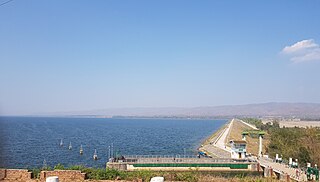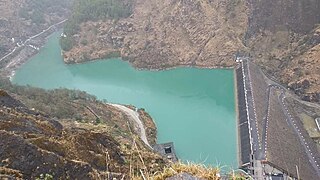Related Research Articles

The Ravi River is a transboundary river crossing northwestern India and eastern Pakistan. It is one of five rivers associated with the Punjab region.

The Jhelum River is a river in the northern Indian subcontinent. It originates at Verinag and flows through the Indian-administered territory of Jammu and Kashmir, into Pakistan-administered Azad Kashmir, then the Pakistani province of Punjab. It is the westernmost of the five rivers of the Punjab region, and flows through the Kashmir Valley. It is a tributary of the Chenab River and has a total length of about 725 kilometres (450 mi).

Teesta River is a 414 km (257 mi) long river that rises in the Pauhunri Mountain of eastern Himalayas, flows through the Indian states of Sikkim and West Bengal and subsequently enters Bangladesh through Rangpur division. In Bangladesh, it merges with Brahmaputra River which after meeting some other major rivers of the Bengal delta finally falls into the Bay of Bengal. It drains an area of 12,540 km2 (4,840 sq mi). In India, the Teesta flows through Mangan District, Gangtok District, Pakyong District, Kalimpong district, Darjeeling District, Jalpaiguri District, Cooch Behar districts and the cities of Rangpo, Jalpaiguri and Mekhliganj. In Bangladesh, it flows through Lalmonirhat District, Rangpur District, Kurigram District and Gaibandha District. It joins the Brahmaputra River at Phulchhari Upazila in Bangladesh. 305 km (190 mi) of the river lies in India and 109 km (68 mi) in Bangladesh. The Teesta is the largest river of Sikkim and second largest river of West Bengal after the Ganges.
The Indira Sagar Dam is the largest dam in India, in terms of volume of water stored in the reservoir. It is located on the Narmada River at the town of Narmada Nagar, Punasa in the Khandwa district of Madhya Pradesh in India. The foundation stone of the project was laid by the prime minister of India Indira Gandhi on 23 October 1984. The construction of the main dam started in 1992. The downstream projects of ISP are Omkareshwar, Maheshwar, and Sardar Sarovar Project. To build it, a town of 22,000 people and 100 villages was displaced.

Salal Dam, also known as Salal Hydroelectric Power Station, is a run-of-the-river hydropower project on the Chenab River in the Reasi district of the Jammu and Kashmir. It was the first hydropower project built by India in Jammu and Kashmir under the Indus Water Treaty regime. After having reached a bilateral agreement with Pakistan in 1978, with significant concessions made to Pakistan in the design of the dam, reducing its height, eliminating operating pool, and plugging the under-sluices meant for sediment management, India completed the project in 1987. The concessions made in the interest of bilateralism damaged the long-term sustainability of the dam, which silted up in five years. It currently runs at 57% capacity factor. Its long-term future is uncertain.

The Rana Pratap Sagar Dam is a gravity masonry dam of 53.8 metres (177 ft) height built on the Chambal River at Rawatbhata in Rajasthan in India. It is part of integrated scheme of a cascade development of the river involving four projects starting with the Gandhi Sagar Dam in the upstream reach in Madhya Pradesh and the Jawahar Sagar Dam on the downstream with a terminal structure of the Kota Barrage in Rajasthan for irrigation.

NHPC Limited is an Indian public sector hydropower company that was incorporated in 1975 to plan, promote and organise an integrated and efficient development of hydroelectric power. Recently it has expanded to include other sources of energy like solar, geothermal, tidal, and wind.

The Chamera Dam impounds the River Ravi and supports the hydroelectricity project in the region. It is located near the town of Dalhousie, in the Chamba district in the state of Himachal Pradesh in India. The reservoir of the dam is the Chamera Lake. Large part of its reservoir lies in Salooni sub-division of Chamba.
The Upper Siang Hydroelectric Project consists of the construction of several hydroelectric power dams in the Upper Siang district of Arunachal Pradesh, India. Construction work on the project was commenced by the National Hydroelectric Power Corporation (NHPC) in April 2009 and various hydro dams will be constructed in phases over a span of 15–20 years.
Dul Hasti is a 390 MW hydroelectric power plant in Kishtwar district of Jammu and Kashmir, India built by NHPC. The power plant is a run-of-the-river type on the Chenab River, in a rugged, mountainous section of the Himalayas, and several hundred kilometers from larger cities in the Jammu Division. It consists of a 70 m (230 ft) tall gravity dam which diverts water through a 9.5 km (5.9 mi) long headrace tunnel to the power station which discharges back into the Chenab. The project provides peaking power to the Northern Grid with beneficiary states being Jammu and Kashmir, Punjab, Haryana, Uttar Pradesh, Uttarakhand, Rajasthan, Delhi and Union Territory of Chandigarh. It was constructed between 1985 and 2007.
Uri Dam is a 480 MW hydroelectric power station on the Jhelum River near Uri in Baramula district of the Jammu and Kashmir, India. It is located very near to the Line of Control, the de facto border between India and Pakistan. The station is largely built under a hill with a 10 km tunnel. It is of the run-of-the-river type without a large dam, since the Indus Waters Treaty gives Pakistan the exclusive right to regulate the Jhelum River. On 4 July 2014 a 240 MW Uri-II power project which is a new project located just downstream of Uri I, was inaugurated.

There are almost 200 large dams in Myanmar. Myanmar (Burma) has a large hydroelectric power potential of 39,000 megawatts (52,000,000 hp), although the economical exploitable potential is about 37,000 megawatts (50,000,000 hp). Between 1990 and 2002, the country tripled its installed capacity of hydro plants, increasing from 253 megawatts (339,000 hp) to 745 megawatts (999,000 hp). Total installed capacity in 2010 is at least 2,449 megawatts (3,284,000 hp) MW, 6% of potential. Several large dams are planned to increase future hydro utilization.

Rangit Dam, which forms the headworks of the Rangit Hydroelectric Power Project Stage III, is a run-of-the-river hydroelectric power project on the Ranjit River, a major tributary of the Teesta River in the South Sikkim district of the Northeastern Indian state of Sikkim. The project's construction was completed in 1999. The project is fully functional since 2000. The project was built at a cost of Rs 4922.6 million. The average annual power generation from the 60 MW project is 340 GWh with firm power of 39 MW.

The Nimoo Bazgo Power Project is a run-of-the-river power project on the Indus River situated at Alchi village, 75 kilometres (47 mi) from Leh in the Indian Union Territory of Ladakh. The project was conceived on 1 July 2001 and approved on 8 June 2005, and construction began on 23rd Sept, 2006. The project involved construction of a 57-high m (187 ft) concrete dam with five spillway blocks of 13 m (43 ft) each having ogee profile. The dam is 247.9m in length. It was officially completed and open in August 2014.
The Kishanganga Hydroelectric Project is a run-of-the-river hydroelectric scheme in Jammu and Kashmir, India. Its dam diverts water from the Kishanganga River to a power plant in the Jhelum River basin. It is located near Dharmahama Village, 5 km (3 mi) north of Bandipore in the Kashmir valley and has an installed capacity of 330 MW.

The Dhauliganga Dam was a concrete face rock and earth-fill embankment dam on the Dhauliganga River near Dharchula in Uttarakhand, India, close to the borders with Tibet and Nepal. It had very little pondage and operated as run-of-the-river. It was constructed by a joint venture of Kajima Construction Corporation, Ltd., and Daewoo Engineering & Construction with Bauer Maschinen. HRT & PH was constructed by JV of [HCC, Hindustan Construction Company] and Samsung Corporation [E&C] Group. It generates 280 MW(4x70 MW) of hydro power.
The Ratle Hydroelectric Plant is a run-of-the-river hydroelectric power station, with permitted pondage under the Indus Water Treaty, currently under construction on the Chenab River, downstream of the village near Drabshalla in Kishtwar district of the Indian Union Territory of Jammu and Kashmir. The project includes a 133 m (436 ft) tall gravity dam and two power stations adjacent to one another. Water from the dam will be diverted through four intake tunnels about 400 m (0.25 mi) southwest to the power stations. The main power station will contain four 205 MW Francis turbines and the auxiliary power station will contain one 30 MW Francis turbine. The installed capacity of both power stations will be 850 MW. On 25 June 2013, Prime Minister Manmohan Singh laid the foundation stone for the dam. Pakistan has frequently alleged that it violates the Indus Waters Treaty.
Sewa-II is a hydroelectric power station located in the Himalayan region in Kathua District Jammu and Kashmir state. It is constructed by NHPC Limited on the Sewa River, a tributary of the Ravi River. Commissioned in 2010, it has a surface power house with the capacity of 120 MW, comprising three Pelton wheel units of 40 MW each, which are fed through a 10km headrace tunnel from the Sewa II Reservoir, giving a maximum water head of 599m. The Sewa II Dam has a height of 53m. The power station generates 534 GW⋅h annually in a 90% dependable year. The beneficiary states of the project include Jammu & Kashmir, Punjab, Haryana, Uttar Pradesh, Uttarakhand, Delhi, Rajasthan and Union Territory of Chandigarh.
Kalijhora is an urban village in the Kalimpong I CD block that lies on the bank of River Teesta, in the Kalimpong Sadar subdivision of the Kalimpong district in the state of West Bengal, India. National Highway 10 connecting Siliguri and Gangtok passes through Kalijhora. Teesta Low Dam - IV Hydropower Plant Dam lies in Kalijhora.

The Lower Periyar Dam is a dam built on the Periyar River as part of the Lower Periyar Hydroelectric Project in Kanjikuzhi Panchayat, Idukki District, Kerala. The dam was built to generate electricity. The lower Periyar dam is at Pambla, five kilometres downstream from where Muthirapuzha merges with main river. This 32.36-metre-high dam made of concrete has a width of 284 meters. The powerhouse is at Karimanal, near Neriamangalam, where three generators are installed with a power production capacity of 60 MW each, or a cumulative 180 MW. The Dam was completed in the year 1998 Taluks through which release flow are Idukki, Kothamangalam, Muvattupuzha, Kunnathunadu, Aluva, Kodungalloor and Paravur.
References
- ↑ Doe, John (1 March 2004). "Chamera II". NHCP Limited. Retrieved 11 April 2016.
- ↑ "Indians Power Scenario". International Journal on Hydropower & Dams. Vol. 12. Aqua-Media International. 2005. p. 115.